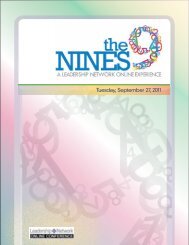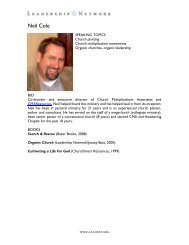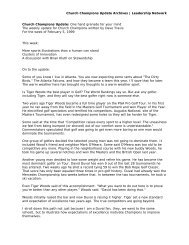ARE WE A PEOPLE AT HALF TIME? - Leadership Network
ARE WE A PEOPLE AT HALF TIME? - Leadership Network
ARE WE A PEOPLE AT HALF TIME? - Leadership Network
Create successful ePaper yourself
Turn your PDF publications into a flip-book with our unique Google optimized e-Paper software.
Four Key Points, continued from page 2<br />
Then, how are we going to give them the people, what we know in terms of opportuauthority,<br />
training and tools to accomplish nity and what we need to make the<br />
this Once the right team is in place, they connection."<br />
Can look at various models and build thk<br />
I<br />
PI^^^^^ for service should not be banchurch-wide<br />
ownership that is needed."<br />
L<br />
dled with a "sink or swim" mentali&.<br />
An effective system places within the Members should be given appropriate<br />
church a way to her care for people and .training and tools for success within their<br />
buiId leadership teams. "The system is work. Mallory suggests that lay ministry<br />
designed to continually equip people, so directors ask themselves these questions:<br />
every year you are adding people and "DO we equip them to serve God through<br />
equipping them for new ministries," the Church and the world", "What are we<br />
explained Sue Mallory, director of doing to support that person" and "Do we<br />
<strong>Leadership</strong> Training <strong>Network</strong>. After an have the ministry descriptions, definitions<br />
initial interview, members are guided of the job, the tools and the training"<br />
through a holistic gift-discovery process, If people are placed where they are gifted<br />
looking at time, talents and the particular and passionate to serve, they will live out<br />
congregation. Once this information is the ministry more fully. To ensure a solid<br />
gathered, the system links the church fit within these positions, members need to<br />
member with appropriate opportunities for understand how the church functions, eleservice.<br />
"You can do discovery all day ments of the job and where resources are<br />
long," said Mallory, '%but if you don't have located. Periodic follow-ups with members<br />
a logical process by which to follow up on are critical. Ultimately, the success of this<br />
information, you just frustrate the new per- process requires solid continuous planson.<br />
Studies have shown that these mem- ning, a dedicated leader and the ability to<br />
bers often depart from the church feeling look at each member's gifts and desire to<br />
unfulfilled."<br />
serve. "IdealIy," emphasized Mallory, "he<br />
Once a person's gifts are identified, a sys- lay mobilkah system needs to beinvisitern<br />
must be in place to make the connec- ble and seamless."<br />
tional link between their talents and<br />
, what is available in the church.<br />
Often in churches, there is little or<br />
y ilization is implemented by a<br />
no coordination in this area; service<br />
mnortunities are word-of-mouth or I! eship team with a specific point-<br />
Gown by a small portion of the I P 1.<br />
-<br />
church staff.<br />
"In Ephesians, we read about the<br />
ligarnknts that connect the body to make it ne of the most important decisions a<br />
whole. I think this is an exquisite anaIogy 0 church will make affecting the future of<br />
for lay mobilization. In our churches, we the lay ministry effort is the selection of the<br />
have all the body parts, but not the liga- team leader or program director. This perments,"<br />
said Mallory. "What a good sys- son's ability to work effmtively with other<br />
tem does is provide the connectional liga- staff and members of the church is critical<br />
ments. It connects what we have, what to the system's success. Identifying leaderwe've<br />
discovered about the richness of our ship and building a strong ministry team<br />
continued on page 4<br />
WH<strong>AT</strong>3 THE DIFFERENCE<br />
BET<strong>WE</strong>EN INNOV<strong>AT</strong>ION AND<br />
nnovations are new ideas that ar<br />
lamented into reality. Innova-<br />
11<br />
tiveness is the ability of a church to<br />
champion, the :.<br />
ion is short-<br />
lived. The key to innovativeness is a<br />
culture that values many peoples'<br />
diverse gifts, and a system that<br />
empowers them to be involved in<br />
creativity and decisionmmaking at all<br />
levels. If you remove any particular<br />
idea or group of people, new inno-<br />
vations will continue to flow. In<br />
essence, lay mobilization is mom<br />
about innwativeness rather than r<br />
particular program, idea, gimrnicl<br />
L<br />
I<br />
How<br />
do 1 u&rsteod Whet is the Bibid Whet is my unque<br />
md become a pnrt besis fa- senrim & of ggifts and<br />
of the church<br />
incemm<br />
hlt€xt<br />
I<br />
Soum: Ths Starkr Kit for Mobilizing Ministry, published by <strong>Leadership</strong> Training Networli<br />
-







